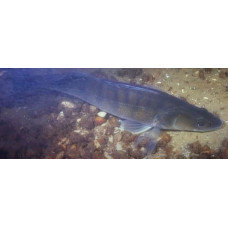Latin name
Sander lucioperca
Other names
Zander, pikeperch
Identification
There are 8-12 short, broad, brown-black horizontal stripes on the sides. The dorsal and caudal fins have rows of dark spots on the webs between the rays. A characteristic feature is the presence of large fang-like teeth on the jaws, which are usually larger in males than in females. Active both day and night. The presence of a reflective layer behind the retina allows it to hunt effectively in low light. At night it moves to shallow water or hunts on the surface, organising the so-called "fight" with the characteristic "sander" splashes. During the day it moves to deeper waters.
Distribution
Widespread in the freshwaters of Eastern Europe and Asia, occurring in the rivers of the basins of the Baltic, Black, Azov, Caspian and Aral Seas, Lakes Issyk-Kul and Balkhash, and in other lakes and desalinated areas of these seas.
Habitat
Usually prefers sandy or gravelly bottoms, especially if there are large objects (stumps, rocks, etc.) that can be used for cover, as the pike-perch is mainly an ambush predator.
Size
A fish of great size. There are individuals over a metre long and weighing up to 10-15 kg, and there are probably larger specimens.
Life history and Behavior
Spawning takes place in spring when the water temperature reaches about 12 degrees Celsius. It chooses shallow areas for spawning, usually with submerged bushes, trees or large debris on the bottom, from half a metre to six metres deep.
Food and feeding habits
The pike-perch is a typical predator. It feeds on fish and small individuals also eat aquatic invertebrates. The basis of the diet is usually fish with a narrow body. These are usually Gobiidae, Cyprinidae, common bleak or freshwater tyulka due to the naturally narrow throat.
Reproduction
The male selects the nesting site and clears it of silt. The eggs are small and yellowish. The fry feed on small invertebrates at first. When they reach a size of about 8-10 cm, the sander switches almost completely to feeding on the young of other fish species, which are abundant in the summer, as they grow much faster. Under good feeding conditions, sander can reach a weight of 500-800 grams in the 2nd year of life. It usually spawns for the first time in the 3-4th year of life.
Interesting facts
Sander are more likely to hunt at night, so they need to see well in the dark. And nature has taken care of that. They have a light-sensitive substance in the retina of their eyes that detects the faintest rays of light.
| Classification | |
| Phylum | Chordata |
| Class | Actinopterygii |
| Squad | Perciformes |
| Family | Percidae |
| Genus | Sander |
| Species | S. lucioperca |
| Features | |
| Conservation status | Least Concern |
| Habitat | Pelagic |
| Life span, years | 17 |
| Maximum body weight, kg | 15 |
| Maximum length, cm | 100 |
| Sailing speed, m/s | 1 |
| Threat to people | Edible |
| Way of eating | Predator |
Sander
Tags: sander


